123rd Airlift Wing
| 123d Airlift Wing | |
|---|---|
 Deployed U.S. Air Force members of the 123rd Airlift Wing, Kentucky Air National Guard, pose with their Lockheed C-130H Hercules aircraft (s/n 91–1232, 91–1233) on a flightline in Afghanistan, 22 April 2009. | |
| Active | 1943–Present |
| Country | |
| Allegiance | |
| Branch | |
| Type | Wing |
| Role | Airlift |
| Part of | Kentucky Air National Guard |
| Garrison/HQ | Louisville Air National Guard Base, Kentucky |
| Motto(s) | Fortune Assists The Brave |
| Tail Code | Kentucky |
| Engagements | World War II |
| Insignia | |
| 123d Airlift Wing emblem |  |
The 123d Airlift Wing (123 AW) is a unit of the Kentucky Air National Guard, stationed at Louisville Air National Guard Base, Kentucky. If activated to federal service, the Wing is gained by the United States Air Force Air Mobility Command.
Overview
The Kentucky Air National Guard's 123rd Airlift Wing mission is to provide worldwide theater airlift for U.S. military and humanitarian operations. The wing is equipped with eight C-130H Hercules aircraft. Multiple groups, squadrons and flights carry out the unit's mission by providing administrative and logistical support, including airlift operations, combat control, pararescue, maintenance, supply, transportation, contracting, communications, civil engineering, personnel, base services, security forces and medical functions.
Units
The 123d Airlift Wing consists of the following units:[1]
- 123d Operations Group
- 123rd Maintenance Group
- 123rd Mission Support Group
- 123rd Medical Group
- 123rd Contingency Response Group
History
World War II

Established in January 1943, the 359th Fighter Group flew 346 combat missions over continental Europe and claimed 373 enemy aircraft in aerial duels and strafing attacks; probable destruction of 23; and damage to 185. It flew its last mission on 20 April 1945. On the ground-support team were the 448th Air Service Group, the 824th Air Engineering Squadron, the 648th Air Material Squadron, and the Third Gunnery and Tow-Target Flight.
The group was organized and trained at the fields of Grenier, Bedford, Farmingdale, and Mitchel in the East, and embarked on its overseas assignment from Westover Field, MA on 2 October 1943, with the main body of troops and flying personnel leaving Westover by train and arriving at Camp Kilmer, NJ that afternoon. On 7 October 1943, the group boarded transports in NY Harbor, arriving in England on 19 October, being assigned to VIII Fighter Command.

The 359th FG entered combat in mid-December 1943 after five 359th FG pilots flew combat missions with the 78th Fighter Group. Began operations with P-47s, later converting to P-51s in April 1944. The role of the station in the general air war strategy was to operate and maintain its fighter aircraft against the enemy for a three-fold purpose: to provide escort and support to the U.S. bombers, to destroy the German Air Forces, both in aerial engagements and by low-level attacks on enemy airdromes, and to furnish close support to advancing Allied troops by strafing and dive-bombing enemy rail and motor transport, equipment and personnel and by flying offensive patrols over the battle lines. At first, the group engaged primarily in escort activities to cover B-17/B-24 bombers that attacked airfields in France, and later expanded their area of operations to provide escort for bombers that struck rail centers in Germany and oil targets in Poland.
The group supported the invasion of Normandy during June 1944 by patrolling the English Channel, escorting bombardment formations to the French coast, and dive-bombing and strafing bridges, locomotives, and rail lines near the battle area.
During the period July 1944 – February 1945, the group engaged chiefly in escorting bombers to oil refineries, marshalling yards, and other targets in such cities as Ludwigshafen, Stuttgart, Frankfurt, Berlin, Merseburg, and Brux. The 359th FG received a Distinguished Unit Citation for operations over Germany on 11 September 1944 when the group protected a formation of heavy bombers against large numbers of enemy fighters.[citation needed]
In addition to its escort duties, the 359th supported campaigns in France during July and August 1944, bombed enemy positions to support the airborne invasion of Holland in September, and participated in the Battle of the Bulge (December 1944 – January 1945). The group flew missions to support the assault across the Rhine in March 1945, and escorted medium bombers that attacked various communications targets, February – April 1945.
The 359th Fighter Group returned to Camp Kilmer, New Jersey and was inactivated on 10 November 1945.
Kentucky Air National Guard
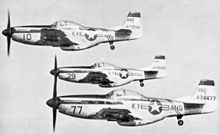
The wartime 359th Fighter Group was re-designated as the 123d Fighter Group, and was allotted to the Kentucky Air National Guard, on 24 May 1946. It was organized at Standiford Field, Louisville, Kentucky, and was extended federal recognition on 9 June 1947 by the National Guard Bureau. The 123d Fighter Group was bestowed the history, honors, and colors of the 359th Fighter Group. The unit was gained by the Tenth Air Force, Continental Air Force.
Upon recognition, the 165th Fighter Squadron was assigned as the Group's operational squadron, and was equipped with F-51D Mustangs. Support squadrons of the group were the 123d Headquarters, 123d Material Squadron (Maintenance), 123d Combat Support Squadron, and the 123d USAF Dispensary.
During the postwar years, the Air National Guard was almost like a flying country club and a pilot could often show up at the field, check out an aircraft and go flying. However, these units also had regular military exercises that kept up proficiency and in gunnery and bombing contests they would often score better than full-time USAF units. The unit's aircrews rapidly attained a high level of combat readiness, and just two years later, the unit earned its first Spaatz Trophy—an award given each year to the premier Air National Guard flying unit.
Korean War Federalization
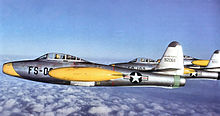
With the surprise invasion of South Korea on 25 June 1950, and the regular military's complete lack of readiness, the ANG was mobilized into federal active duty. The 165th Fighter Squadron was federalized and ordered to active duty on 10 October 1950. The squadron was moved to Godman Air Force Base at Fort Knox along with the 123d Fighter Group. At Godman, the squadron was joined by the North Carolina ANG 156th Fighter Squadron and the West Virginia ANG 167th Fighter Squadron. All three squadrons were equipped with F-51Ds.
After over a year of training at Godman AFB, the 123d was re-designated as a Fighter-Bomber Group and deployed to RAF Manston, Kent, England to replace the Strategic Air Command 12th Fighter-Escort Wing which was returned to Bergstrom AFB, Texas. In England, the mission of the 123d was to provide fighter escort for SAC B-50 Superfortress and B-36 Peacemaker bombers while flying over Western European airspace on their deterrence alert missions. The 123d left their F-51Ds at Godman AFB and the personnel boarded C-47s to Westover AFB, MA and later to transport ships to England. They arrived in early December, 1951 at RAF Manston where they initially began conversion training on F-84E Thunderjets.
The training program began with the inexperienced F-51D pilots experiencing training difficulties with the jet aircraft, with several aircraft being lost in accidents. However, by March 1952 the 134th was judged to be 80% combat ready on the Thunderjets. However, the period of federalization for the 123d was expiring and in July 1952, the unit personnel were returned to the United States, the aircraft at RAF Manston being passed on to the active-duty 406th Fighter-Bomber Wing was activated in place.
Tactical Fighter mission

After returning from England, the unit re-formed at Louisville. Because most jet aircraft were still in USAF use, the squadron received F-51D Mustangs and initially returned to its pre-federalization air defense mission, being designated as a Fighter-Interceptor unit. However, with the F-51s, the Kentucky Air National Guard was limited to daylight training only.
On 1 January 1953, the Group was transferred to Tactical Air Command jurisdiction and re-equipped with refurbished F-86A Sabre air superiority fighter. With the switchover to TAC, the unit designation was changed to "Fighter-Bomber".
Tactical Reconnaissance mission
The 165th only flew the Sabre for two years, when it was re-equipped with Martin RB-57A Canberra reconnaissance aircraft. The 123d became a Tactical Reconnaissance Wing, in which it would remain for the next thirty years. The 165th would perform day and night, high and low, and visual and photographic reconnaissance. Unlike the Sabre fighters, the RB-57A was totally unarmed. The crew was two—one pilot and one photo-navigator One of their major activities of the 123d in the United States was to carry out photographic surveys of areas hit by natural disasters such as hurricanes or tornadoes. In 1965, the 123d was awarded its second Spaatz Trophy for superior combat readiness and flight training.

In 1965, the unit transferred its RB-57s to active duty to be deployed to South Vietnam. In return the 123d was re-equipped, receiving the RF-101G Voodoo. The RF-101G was a derivative aircraft from twenty-nine ex-USAF F-101A Tactical Fighters that were withdrawn from fighter duty and were modified by Lockheed Aircraft Service Company of Ontario, California to serve as unarmed tactical reconnaissance aircraft for use by the Air National Guard These aircraft were re-designated as RF-101G. As compared to the RF-101A dedicated photo-reconnaissance version of the F-101A, the RF-101G had a shorter and broader nose. These aircraft went to the Kentucky Air National Guard in July 1965, replacing the RB-57B.

On 26 January 1968, the Pueblo Crisis precipitated the 123d's recall to federal service. Now officially known as the 123d Tactical Reconnaissance Wing, the unit flew just under 20,000 tactical flying hours with the RF-101G and delivered nearly 320,000 reconnaissance prints to requesting agencies. Assigned personnel served on active duty for 16 months.
The 123d TRW experienced a rocky tour of active duty. The wing had not been rated combat-ready when mobilized on 26 January 1968 primarily due to equipment shortages. It was not part of Secretary McNamara's Selected Reserve Force. The unit was given an unsatisfactory ORI rating in October 1968. Despite those problems, the 123d made a significant contribution to active force operations. It began functioning as the primary Air Force tactical reconnaissance unit in the continental U.S. Elements of its squadrons rotated temporary duty assignments in Japan and South Korea from July 1968 until April 1969 providing photo reconnaissance support to American forces in those areas, including service in South Vietnam flying combat reconnaissance missions.
The 123d was released from active duty and returned to Kentucky state control on 8 June 1969. The wing earned its first Air Force Outstanding Unit Award for its exceptional performance during this period.

In 1971, there was a re-organization of Air National Guard tactical reconnaissance units, with all the RF-101Gs being sent to the Arkansas ANG 184th Tactical Reconnaissance Squadron. The Kentucky ANG transferred its RF-101Gs to the Arkansas ANG and transitioned to the RF-101H Voodoo, a follow-on to the RF-101G. Being derived from the F-101C tactical fighter, the RF-101H differed from the RF-101G in having a strengthened airframe designed to allow maneuvers at up to 7.33 G. and having different fuel pumps and fuel feed and control systems, increasing its maximum available afterburner time from six minutes to 15.
During 1976, a no-notice conversion announced by the National Guard Bureau brought the two-seat RF-4C Phantom II to the Kentucky Air National Guard, with the RF-101Hs aircraft being retired to AMARC. The unit attained combat-ready status within seven months—a record time. The Phantom years were marked with many overseas deployments, participation in international photo reconnaissance competitions and a remarkable flight safety record. In 1981, the unit placed first in the Air National Guard Photo Finish Competition and earned an unprecedented third Spaatz Trophy.
In May 1983 the unit reached another historic milestone when it earned the highest possible rating from Tactical Air Command during its Operational Readiness Inspection. This was the first time that a TAC unit had received an outstanding rating. On 1 January 1989 the unit was awarded its seventh Air Force Outstanding Unit Award—a record for any Air National Guard unit.
Tactical airlift
The collapse of the Soviet Union and the dissolution of the Warsaw Pact led to accelerated retirement plans for active duty USAF RF-4Cs. In 1988, the Kentucky Air National Guard's Phantoms were sent to AMARC, and on 9 January 1989 the 123d was officially re-designated the 123d Tactical Airlift wing and began conversion to the C-130B Hercules transport aircraft. By the end of the year, the unit had been involved in many worldwide airlift missions, including exercise Volant Oak in Panama. The unit also participated in an airlift competition, Sentry Rodeo. The wing's first humanitarian airlift came in the aftermath of Hurricane Hugo.
Although the 165th Tactical Airlift Squadron, the wing's flying component, was not federally mobilized for Operations Desert Shield and Desert Storm, unit volunteers stepped forward to support the war effort. From August 1990 to March 1991, the 165th flew 1,240 airlift sorties worldwide in direct support of the Gulf War—the most for any Air National Guard unit. An additional 88 wing members were activated in support of Desert Shield/Storm.
Post Cold War era
In May 1992 the 123d received the 2000th C-130 straight off the assembly line as it began conversion to the C-130H Hercules. Eight months later, the 123rd deployed to Mombassa, Kenya, to fly relief missions into Somalia for Operation Restore Hope and Operation Provide Relief. Citizen-soldiers from the 123d flew 150 sorties and transported 720 tons of relief supplies and 1,444 passengers into some of the hardest-hit areas in Somalia.
When the world's attention shifted to Eastern Europe in February 1993, the 123d responded again, deploying in support of Operation Provide Promise. The unit's all-volunteer force flew 1,082 airdrop and air-land sorties and delivered 2,215 tons of food and supplies into war-torn Bosnia-Herzegovina. To support the operation, the wing deployed 451 personnel into Rhein-Main Air Base, Germany, over several rotations until May 1994.
In July 1994 the 123d answered another call for help and deployed within 72 hours of notification to fly relief missions into Rwanda and Zaire for Operation Support Hope. Operating out of Mombassa, Kenya, unit personnel flew 147 sorties, transporting 652.5 tons of relief supplies to the beleaguered Rwandan refugees. Personnel from the unit's 205th Combat Communications Squadron also deployed to Haiti that year as part of Operation Uphold Democracy, providing satellite communications links for the theater commander.
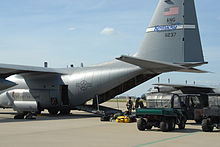
In September 1994 the wing's sustained record of achievement was recognized by award of the 1993 Curtis N. Rusty Metcalf Trophy, presented annually to the best Air National Guard airlift or air refueling unit. The wing also earned the Air National Guard Distinguished Flying Unit Plaque and Air Force Flight Safety Plaque. In November 1994 the unit was granted its eighth Air Force Outstanding Unit Award.
The wing returned to Bosnia in 1996 to provide airlift for U.S. and NATO troops who were protecting the fragile peace. More than 170 Kentuckians volunteered for the mission, which delivered 913 tons of cargo and transported 2,296 passengers. The wing also achieved the highest readiness rate of any unit in the theater. That commitment to service continued in 1997, when the unit participated in several overseas deployments while offering a helping hand at home. More than 100 Kentucky Air Guard troops provided security forces, medical aid, communications links and civil engineering crews after record flooding ravaged several Kentucky communities.
The unit also made its presence felt overseas, offering civil engineering skills in Spain and airlift services in Saudi Arabia as part of Operation Southern Watch, which enforced the no-fly zone in Southern Iraq. Other wing members deployed to Egypt as part of a multinational training exercise that integrated 7,000 troops from every branch of the U.S. military and six foreign countries.
In February 1998, the 123d Airlift Wing received its ninth Air Force Outstanding Unit Award. The following month, the wing accepted its sixth Distinguished Flying Unit Plaque, recognizing the 123d Airlift Wing as one of the top five Air Guard flying units in the nation for 1997. A mere three months later, the wing as presented with the 15th Air Force Reserve Forces Trophy as the top reserve unit in the numbered Air Force.
1998 continued the 123rd Airlift Wing's tradition of global deployments with missions to Panama as part of Operation Coronet Oak and Ecuador for Nuevos Horizontes '98. The latter operation, whose name means New Horizons in Spanish, was a Southern Command joint training exercise that gave Kentucky Army and Air Guard engineers the opportunity to fine-tune military skills while constructing clinics, schools, and latrines in rural areas of the South American nation. Nearly 1,300 of the Commonwealth's citizen-soldiers participated in the effort, which also provided impoverished Ecuadorians with basic dental and medical care.
The following year, the wing returned to Bosnia once more to provide theater airlift for the continuing peacekeeping mission, now called Operation Joint Forge. More than 350 Kentucky aircrew, maintainers, and support personnel deployed for the operation, along with about 200 members of the Ohio Air National Guard's 179th Airlift Wing.
The two unit's C-130s flew nearly 500 sorties during the deployment, delivering 3,500 passengers and more than 1,000 tons of cargo to sites across Europe and inside Bosnia, including Sarajevo and Tuzla. The units also were tasked with helping stockpile equipment for what became Operation Allied Force, the NATO air campaign against Serbian forces in the former Republic of Yugoslavia. Working around the clock with the 37th Airlift Squadron at Ramstein Air Base, Germany, the Kentucky and Ohio crews flew more than 70 tons of fighter support equipment from U.S. bases in England and Germany to bases in Italy. The Kentucky Air Guard closed out 1999 by again deploying for Operation Southern Watch, providing theater airlift services from an air base in Muscat, Oman.
The wing's eagerness to volunteer for such demanding missions — and to complete them with unparalleled success — was rewarded yet again in March 1999 when the 123d received an unprecedented second-consecutive 15th Air Force Reserve Forces Trophy.
Air Expeditionary deployments
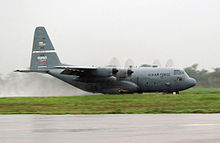
In mid-1996, the Air Force, in response to budget cuts, and changing world situations, began experimenting with Air Expeditionary organizations. The Air Expeditionary Force (AEF) concept was developed that would mix Active-Duty, Reserve and Air National Guard elements into a combined force. Instead of entire permanent units deploying as "Provisional" as in the 1991 Gulf War, Expeditionary units are composed of "aviation packages" from several wings, including active-duty Air Force, the Air Force Reserve Command and the Air National Guard, would be married together to carry out the assigned deployment rotation.
Shortly thereafter, the unit began planning for a 90-day deployment to Muscat, Oman, to again support U.S. troops enforcing the no-fly zone in Southern Iraq. More than 160 personnel were joined by members of the Ohio Air Guard's 179th Airlift Wing to support Operation Northern Watch. Together, the two units flew 345 sorties during their three-month tasking, delivering 895 tons of cargo and 1,122 passengers to destinations in Qatar, Saudi Arabia and the United Arab Emirates. The mission, which was part of the Air Force's first-ever Aerospace Expeditionary Force, concluded in December 1999.
By April 2000 the 123d Airlift Wing had received its 10th Air Force Outstanding Unit Award, and global deployments continued to mark the wing's activities.
More than 580 Kentucky Air Guard members deployed overseas from Dec. 2000 to March 2001 as part of Air Expeditionary Forces based in Germany and Southwest Asia. Other unit members were sent to South America to participate in drug interdiction efforts. The largest contingent of Kentucky forces—nearly 470 aircrew, maintenance and support personnel—operated from Ramstein Air Base, Germany, in support of Operation Joint Forge, the multinational peacekeeping mission in Bosnia-Herzegovina. While there, unit members transported approximately 2,500 passengers and 410 tons of cargo to locations like Sarajevo and Tuzla, Bosnia; and Taszar, Hungary.
Other 123d members deployed to Kuwait, Saudi Arabia, the United Arab Emirates and Turkey in support of Operation Joint Forge, Operation Southern Watch and Operation Northern Watch. The latter two missions are responsible for enforcing no-fly zones imposed upon Iraq following the 1991 Gulf War.
Global War on Terrorism
After the Sept. 11, 2001, terrorist attacks, unit members were tasked to participate in the war against terrorism and in homeland defense. Currently, more than 500 Kentucky ANG troops have been called to active duty for at least a year while scores of additional troops are serving on short-term duty as needed to support Operation Noble Eagle and Operation Enduring Freedom.
In the first half of 2002, the wing received three major honors recognizing its superior performance in 2001. The awards were the 15th Air Force Solano Trophy, given each year to the top reserve unit in the 15th Air Force; the Metcalf Trophy, given annually to the best tanker or airlift unit in the Air National Guard; and the Air Force Outstanding Unit Award—the wing's 11th such honor.
The wing also stood up the Air National Guard's first Contingency Response Group—a rapid-reaction "airbase in a box" with all the personnel, training and equipment needed to deploy to a remote site, open up a runway and establish airfield operations so that aid and troops can begin to flow into affected areas after a disaster.
The group was instrumental in responding to the statewide ice storm last year that left nearly 770,000 households without power and water for days. All told, the wing deployed more than 380 Airmen across the Commonwealth to clear roads, distribute food and water and conduct house-to-house "wellness checks" credited with saving two people from death by carbon monoxide poisoning.
The unit was equally engaged back home. When Hurricane Gustav began closing in on the Gulf Coast in August 2008, the 123d Airlift Wing provided the facilities and support for relief agencies to evacuate more than 1,400 New Orleans residents to Louisville and then repatriate them after the danger had passed.
In 2009, the Wing was awarded its 14th Air Force Outstanding Unit Award for accomplishments from Oct. 1, 2007 to Sept. 30, 2009. During those two years, the wing stepped up to perform numerous critical missions at home and abroad, deploying 759 personnel to 62 locations in 20 countries—many of them in harm's way. For example, about 300 Kentucky Airmen and multiple C-130 aircraft were deployed to Bagram Air Base, Afghanistan, from March through May 2009 to provide key airlift support for U.S. forces engaged with the enemy in Operation Enduring Freedom.
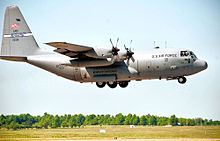
The unit maintained an unprecedented 100 percent mission-capable rate during the deployment, never missing a single scheduled flight due to aircraft maintenance issues while completing more than 1,500 combat sorties that delivered 3,900 tons of cargo and transported 20,000 troops throughout the theater of operations. The wing also deployed more than 120 Airmen and two C-130 aircraft to the Caribbean in support of Operation Coronet Oak, an ongoing U.S. Southern Command mission to provide theater airlift capability for U.S. military and government agencies in Central and South America.
A third major overseas deployment saw more than 200 Kentucky Air Guardsmen and three C-130 aircraft deploy to Ramstein Air Base, Germany, from January through March 2008 and August through September 2009 as part of Operation Joint Enterprise. Kentucky aircrews transported more than 200 tons of cargo and 700 troops to 18 nations across Europe and Africa during their tours.
BRAC 2005
In its BRAC 2005 Recommendations, DoD recommended to realign Berry Field Air National Guard Base, Nashville, Tennessee. This recommendation would distribute the C-130H Hercules aircraft of the 118th Airlift Wing (ANG) to the 123d Airlift Wing (ANG), Louisville Air National Guard Base (four aircraft) and another installation. Military judgment was the predominant factor in this recommendation—this realignment would create one right-sized squadron at Louisville (79) and would retain experienced ANG personnel.
Lineage



- Constituted as 359th Fighter Group on 20 December 1942
- Activated on 5 January 1943
- Inactivated on 10 November 1945
- Re-designated: 123d Fighter Group and allocated to Kentucky ANG on 24 May 1946
- Extended federal recognition on 20 Sep 1947
- Federalized and ordered to active service on: 10 October 1950
- Re-designated: 123d Fighter-Bomber Group, 1 November 1951
- Released from: active duty and returned to Kentucky state control, 10 July 1952
- Re-designated: 123d Fighter-Interceptor Group, on 10 Jul 1952
- Re-designated: 123d Fighter-Bomber Group on 1 January 1953
- Re-designated: 123d Tactical Reconnaissance Group, 1 June 1957
- Federalized and ordered to active service on: 26 January 1968
- Status changed from Group to Wing, 26 January 1968
- Re-designated: 123d Tactical Reconnaissance Wing, 26 January 1968
- Released from active duty and returned to Kentucky state control, 9 June 1969
- Re-designated: 123d Tactical Airlift Wing, 8 January 1989
- Re-designated: 123d Airlift Wing, 16 March 1992
Assignments
- I Fighter Command, 15 January 1943
- Attached to: New York Fighter Wing, 11 July – 23 August 1943
- Attached to: Boston Fighter Wing, 23 August – 2 October 1943
- 66th Fighter Wing, 20 October 1943
- 67th Fighter Wing, 1 November 1943
- Attached to: 1st Bombardment (later Air) Division, 15 September 1944 – 2 November 1945
- Army Service Forces (for inactivation), 9–10 November 1945
- 55th Fighter Wing, 20 September 1947
- 123d Fighter Wing*, 10 October 1950
- 123d Fighter-Bomber Wing*, 1 November 1951
- Kentucky Air National Guard, 16 February 1947
- Gained by: Tactical Air Command
- Tactical Air Command, 26 January 1968
- Kentucky Air National Guard, 9 June 1969 – Present
- Gained by: Tactical Air Command
- Gained by: Military Airlift Command, 8 January 1989
- Gained by: Air Mobility Command, 1 June 1992
- Gained by: Air Combat Command, 1 October 1993
- Gained by: Air Mobility Command, 1 April 1997
*Note: The 123d Fighter Wing was established and activated by Tactical Air Command when the unit was federalized on 10 October 1950; the 123d Fighter Group becoming a subordinate unit of the Wing. It was assigned to Ninth Air Force, Tactical Air Command on 26 October 1950. Re-designated 123d Fighter-Bomber Wing on 1 November 1951 when the unit received F-84E Thunderjets and was attached to Third Air Force, United States Air Forces in Europe. Inactivated 10 July 1952 when the unit was returned to Kentucky state control. There is no lineage or history to the 123d Airlift Wing beyond the period of the Korean War federalization.
Components
- 123d Operations Group, 16 March 1992 – Present
- 165th Fighter (later Fighter-Bomber, Fighter-Interceptor, Tactical Reconnaissance, Tactical Airlift, Airlift) Squadron, 16 February 1947 – Present
- 368th Fighter Squadron (CV) 15 January 1943 – 10 November 1945
- 369th Fighter Squadron (IV) 15 January 1943 – 10 November 1945
- 370th Fighter Squadron (CR) 15 January 1943 – mid-March 1944 then (CS) – 10 November 1945
Stations
|
|
Aircraft
|
|
Decorations
- Awarded: 1970, 1979, 1982, 1983,1985, 1987, 1989, 1994, 1998, 1999, 2002, 2005, 2008, 2009, 2011
References
![]() This article incorporates public domain material from the Air Force Historical Research Agency
This article incorporates public domain material from the Air Force Historical Research Agency
Additional reading
- Globalsecurity.org 123d Airlift Wing
- 123d Airlift Wing history factsheet
- Rogers, B. (2006). United States Air Force Unit Designations Since 1978. ISBN 1-85780-197-0
- Fogg, Richard & Janet, Fogg in the Cockpit: Howard Fogg-Master Railroad Artist, World War II Fighter Pilot. Casemate Publishers & Book Distributors, 2011 ISBN 978-1-61200-004-6
- Freeman, Roger A. Airfields of the Eighth: Then and Now. After the Battle, 1978. ISBN 0-900913-09-6.
- Freeman, Roger A. The Mighty Eighth: The Colour Record. Cassell & Company, 1991. ISBN 0-304-35708-1.
- Maurer, Maurer, Air Force Combat Units of World War II, Office of Air Force history (1961). ISBN 0-405-12194-6
- Miller, Kent D. Jigger, Tinplate and Redcross: the 359th Fighter Group in World War II. Fort Wayne, Indiana: Academy Publishing Corporation, 1987.
- Smith, Jack H. Mustangs and Unicorns: A History of the 359th Fighter Group. Missoula, MT: Pictorial Histories Publishing, 1997. ISBN 1-57510-029-0.
- Smith, Jack H. 359th Fighter Group. Oxford: Osprey, 2002. ISBN 978-1-84176-440-5.
External links
- 123d Airlift Wing Official Website
- Global Security
- Kentucky National Guard eMuseum
- YouTube
- Fogginthecockpit
- usaaf.com 359th Fighter Group
- littlefriends.co.uk 359th Fighter Group
- USAF Aircraft Serial Number Search



